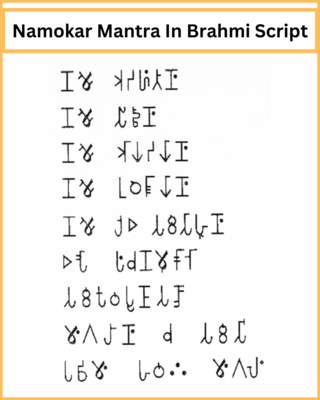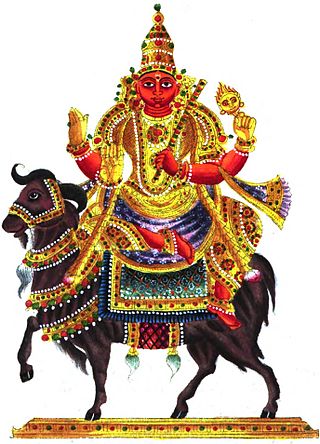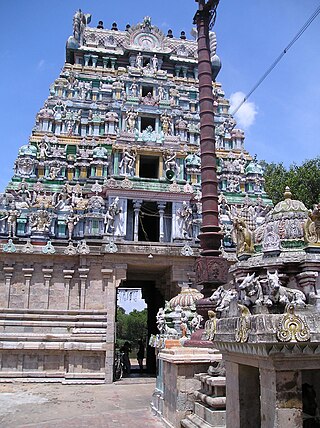Related Research Articles

Puja is a worship ritual performed by Hindus, Buddhists and Jains to offer devotional homage and prayer to one or more deities, to host and honor a guest, or to spiritually celebrate an event. It may honor or celebrate the presence of special guests, or their memories after they die. The word pūjā is Sanskrit, and means reverence, honor, homage, adoration, and worship. Puja, the loving offering of light, flowers, and water or food to the divine, is the essential ritual of Hinduism. For the worshipper, the divine is visible in the image, and the divinity sees the worshipper. The interaction between human and deity, between human and guru, is called darshan, seeing.

A mantra or mantram is a sacred utterance, a numinous sound, a syllable, word or phonemes, or group of words in Sanskrit, Pali and other languages believed by practitioners to have religious, magical or spiritual powers. Some mantras have a syntactic structure and literal meaning, while others do not.

Om is a sacred sound, syllable, mantra, and an invocation in Hinduism. Om is one of the most important symbols of Hinduism. It is variously said to be the essence of the supreme Absolute, consciousness, Ātman,Brahman, or the cosmic world. In Indic traditions, Om serves as a sonic representation of the divine, a standard of Vedic authority and a central aspect of soteriological doctrines and practices. The syllable is often found at the beginning and the end of chapters in the Vedas, the Upanishads, and other Hindu texts.
Saṃhitā literally means "put together, joined, union", a "collection", and "a methodically, rule-based combination of text or verses". Saṃhitā also refers to the most ancient layer of text in the Vedas, consisting of mantras, hymns, prayers, litanies and benedictions.

The Gāyatrī Mantra, also known as the Sāvitri Mantra, is a highly revered mantra from the Rig Veda, dedicated to the Vedic deity Savitr. Gāyatrī is the name of the Goddess of the Vedic meter in which the verse is composed. Its recitation is traditionally preceded by oṃ and the formula bhūr bhuvaḥ svaḥ, known as the mahāvyāhṛti, or "great (mystical) utterance". The Gayatri mantra is cited widely in Hindu texts, such as the mantra listings of the Śrauta liturgy, and classical Hindu texts such as the Bhagavad Gita, Harivamsa, and Manusmṛti. The mantra and its associated metric form was known by the Buddha. The mantra is an important part of the upanayana ceremony. Modern Hindu reform movements spread the practice of the mantra to everyone and its use is now very widespread.

Mangala is the personification, as well as the name for the planet Mars, in Hindu literature. Also known as Lohita, he is the deity of anger, aggression, as well as war. According to Vaishnavism, he is the son of Bhumi, the earth goddess, and Vishnu, born when the latter raised her from the depths of the primordial waters in his Varaha avatar.
Prayer is considered to be an integral part of the Hindu religion; it is practiced during Hindu worship (puja) and is an expression of devotion (bhakti). The chanting of mantras is the most popular form of worship in Hinduism. Yoga and meditation are also considered as a form of devotional service.
Om Namah Shivaya is one of the most popular Hindu mantras and the most important mantra in Shaivism. Namah Shivaya means "O salutations to the auspicious one!", or “adoration to Lord Shiva". It is called Siva Panchakshara, or Shiva Panchakshara or simply Panchakshara meaning the "five-syllable" mantra and is dedicated to Shiva. This Mantra appears as 'Na' 'Ma' 'Śi' 'Vā' and 'Ya' in the Shri Rudram Chamakam which is a part of the Krishna Yajurveda and also in the Rudrashtadhyayi which is a part of the Shukla Yajurveda.

A Hindu wedding, also known as Vivaha, Marathi: Lagna (लग्न), Kalyanam or Pelli is the traditional wedding ceremony for Hindus. The wedding ceremonies are very colourful, and celebrations may extend for several days. The bride's and groom's home—entrance, doors, wall, floor, roof—are sometimes decorated with colors, flowers, and other decorations.
The following list consists of notable concepts that are derived from Hindu culture and associated cultures traditions, which are expressed as words in Sanskrit or other Indic languages and Dravidian languages. The main purpose of this list is to disambiguate multiple spellings, to make note of spellings no longer in use for these concepts, to define the concept in one or two lines, to make it easy for one to find and pin down specific concepts, and to provide a guide to unique concepts of Hinduism all in one place.

The Ṇamōkāra mantra or Navkar Mantra is the most significant mantra in Jainism, and one of the oldest mantras in continuous practice. This is the first prayer recited by the Jains while meditating. The mantra is also variously referred to as the Pancha Namaskāra Mantra, Namaskāra Mantra, Navakāra Mantra, Namaskāra Mangala or Paramesthi Mantra.

Dakshinamurti is an aspect of the Hindu god Shiva as a guru (teacher). He is regarded to be the personification of the supreme or the ultimate awareness, understanding, and knowledge. Dakshinamurti represents Shiva as a teacher of yoga, music, and wisdom, offering an exposition of the Shastras. He is worshipped as the god of wisdom and meditation.

Sandhyavandanam is a mandatory religious ritual centring around the recitation of the Gayatri mantra, traditionally supposed to be performed three times a day by Dvija communities of Hindus, particularly those initiated through the sacred thread ceremony referred to as the Upanayanam and instructed in its execution by a Guru, in this case one qualified to teach Vedic ritual. Sandhyopasana is considered as a path to attain salvation (moksha).
The Shanti Mantras, or "Peace" or Pancha Shanti mantras, are Hindu prayers for peace (shanti) found in the Upanishads. Generally, they are recited at the beginning and end of religious rituals and discourses.
The Yogatattva Upanishad, also called as Yogatattvopanishad (योगतत्त्वोपनिषत्), is an important Upanishad within Hinduism. A Sanskrit text, it is one of eleven Yoga Upanishads attached to the Atharvaveda, and one of twenty Yoga Upanishads in the four Vedas. It is listed at number 41 in the serial order of the Muktika enumerated by Rama to Hanuman in the modern era anthology of 108 Upanishads. It is, as an Upanishad, a part of the corpus of Vedanta literature collection that present the philosophical concepts of Hinduism.

Kalyanasundaresar Temple, Nallur or Thirunallur is a Hindu temple dedicated to the deity Shiva in Nallur, Tamil Nadu, India. It is located 10 km (6.2 mi) away from Kumbakonam, 6 km (3.7 mi) east of Thirukkarugavur, and 30 km (19 mi) south of Thanjavur.
Mantrapushpanjali is a popular prayer in India, it is the unique prayer of hindus and it means “offering flowers in the form of mantra”. It comprises four hymns from Vedic sources, and is the final prayer sung at the end of āratīs. The word Mantrapushpanjali is made up of three elements, mantra (incantation), pushpa (flower), and anjali.
The Pavamana Mantra, also known as pavamāna abhyāroha is an ancient Indian mantra introduced in the Bṛhadāraṇyaka Upaniṣad (1.3.28.) The mantra was originally meant to be recited during the introductory praise of the soma sacrifice by the patron sponsoring the sacrifice.

The Kalagni Rudra Upanishad, is one of the minor Upanishads of Hinduism, written in the Sanskrit language. It is attached to the Krishna Yajurveda. It is one of 14 Shaiva Upanishads.

The Nrisimha Tapaniya Upanishad is a minor Upanishadic text written in Sanskrit. It is one of the 31 Upanishads attached the Atharvaveda, and classified as one of the Vaishnava Upanishads. It is presented in two parts, the Purva Tapaniya Upanishad and the Uttara Tapaniya Upanishad, which formed the main scriptures of Narasimha sect of the Vaishnavas dated prior to the 7th century.
References
- ↑ Gopal, Balakrishnan Raja; Ritti, Shrinivas (2004). Inscriptions of the Rulers of the Sangama Dynasty (1336 A.D.-1485 A.D.). Indian Council of Historical Research and Northern Book Centre. ISBN 9788172111687.
- Balakrishnan Raja Gopal, Shrinivas Ritti. Inscriptions of the Rulers of the Sangama Dynasty (1336 A.D.-1485 A.D.). Indian Council of Historical Research and Northern Book Centre, 2004 - Inscriptions, Kannada, p. 1022.